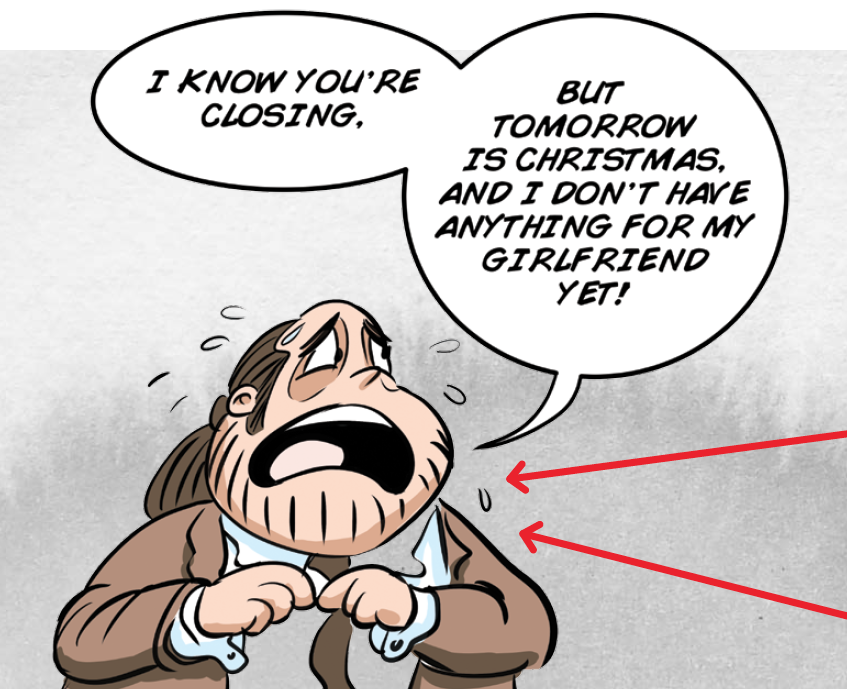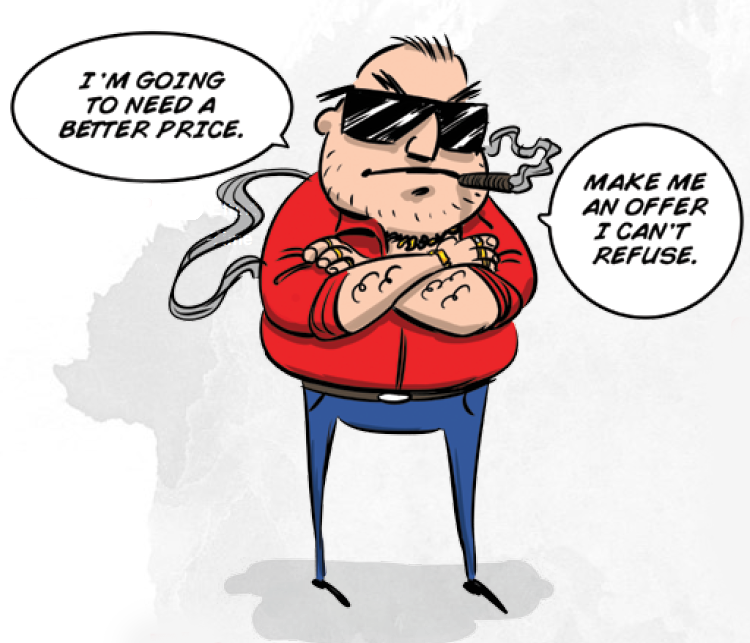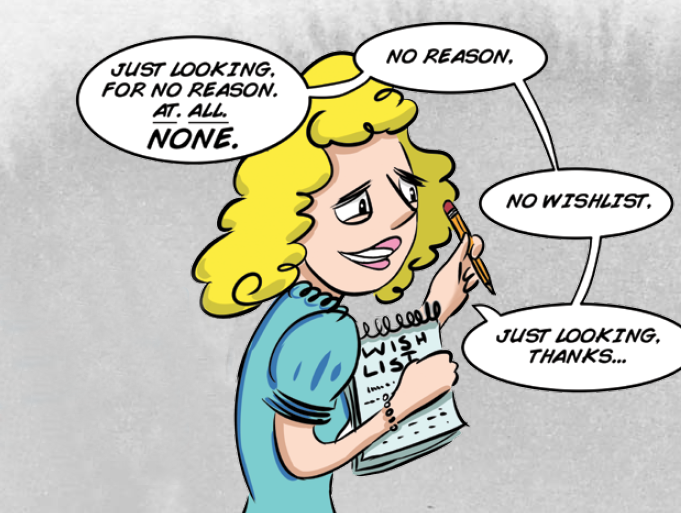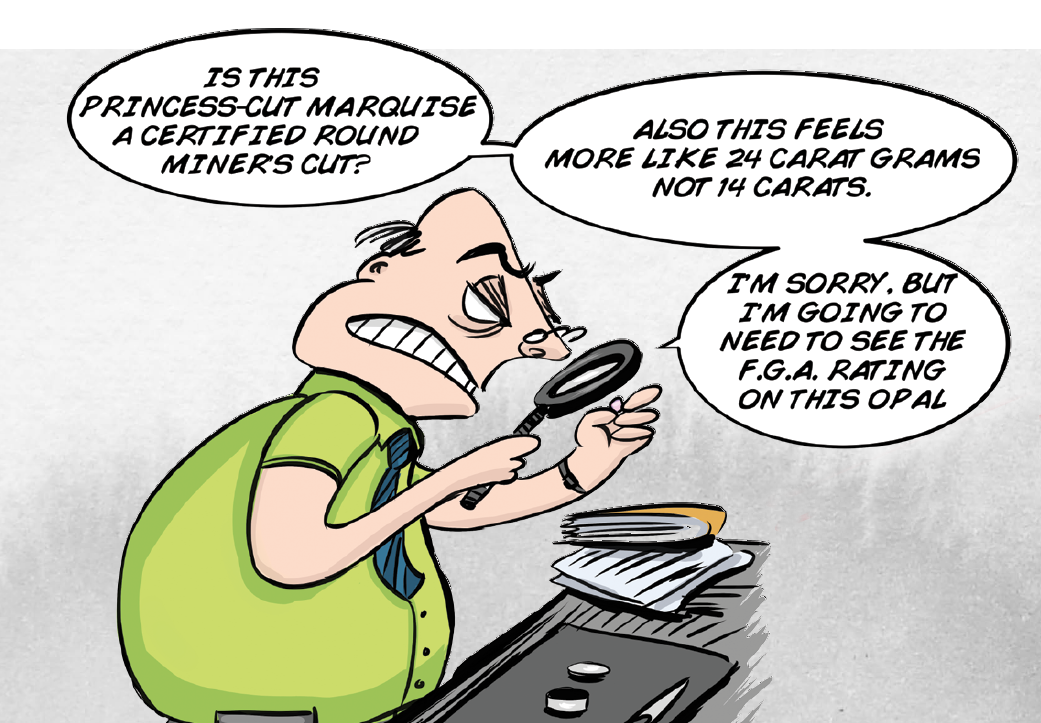This story was originally published in the November 2015 edition of INSTORE.
SOMETIMES IT’S HARD to believe how much of your business success rests on the whims of Christmas shoppers who stop by once a year. But since this is often the case, try taking some of the whimsy out of your business by preparing for everyone who’s likely to show up. As James Gattas of James Gattas Jewelers in Memphis, TN, puts it, every type of customer “comes out of the woodwork” this time of year. Joan Charlene Little of Genesis Jewelry in Muscle Shoals, AL, reports that she has seen it all, including customers wearing pajamas, who appear to have come straight out of bed.
Luckily, quite a few holiday shoppers are low-drama, says Christina O’Hara of Blue Mountain Gems in Roanoke, VA. “I love the Weekend Wildman who comes in, throws money on the counter and wants to know ‘What can I get for this much?’ Then I love, love, love the Wishlist Warriors: ‘My wife/girlfriend said she has a wish list.’ Show them what’s available or upsell, wrap it and have them out the door in time to have a holiday beer before they head home.”
But there are also the Frazzled Frannies, comparison shoppers who want the return policy read word for word. “They will ask: Are you going to give me credit for the complimentary sizing since this is the right size? This is where those hours of role play will pay off!” says O’Hara.
After consulting with experts Shane Decker of Ex-Sell-Ence Sales Academy, Becka Johnson Kibby, sales and training manager for The Edge Retail Academy, and Kate Peterson of Performance Concepts, we’ve come up with detailed advice for the holiday customer types mentioned most often by our Brain Squad contributors.
But it all boils down to this: Be grateful for the traffic, (no matter how odd, under-dressed or melodramatic), treat everyone with respect, provide a “wow” experience, and make the kind of friendly first impression that will lead to a long and profitable relationship.

The Desperado
PROFILE: “I have one customer in particular who always stands out every Christmas Eve,” says Michael Kanoff of Michael’s Jewelers in Fairless Hills, PA. “He always says ‘You’ve got five minutes to pick a gift she is going to like and wrap it and get me out of here.’ I used to ask, ‘What do you want to spend?’ He always replies, ‘I don’t care; you’re now down to four minutes.’ This has been going on for 18 years. Now he stays and talks and we joke about the five minutes.” Some Desperados do have a clue in the form of a wish list, but it may be too late for that to save them. “We love the last-minute guy, always a guy, who comes in Dec. 22 or Dec. 23 and starts by saying ‘Last August, my wife saw …’ and then is upset that we don’t have the item,” says Rosanne Kroen of Rosanne’s Diamonds & Gold in South Bend, IN. “I think they don’t really want to spend the money and the excuse is always ‘The store didn’t have it.’ We usually can sell them something, but not always!”
WORST-CASE SCENARIO: If this shopper is frazzled and fried, it’s easy for the salesperson to get sucked into that frame of mind, to get as frantic as the customer, which serves nobody’s best interest, Peterson says. Or, it’s easy for a wish-list stickler to leave in defeat, when the specific item isn’t available. At that point, you might be tempted, as Christina O’Hara of Blue Mountain Gems in Roanoke, VA, often is, to say, “Are you nuts? You actually want to go back out in that traffic and drive somewhere else that might not be open?”
DO SAY: “Try one of these hot trends that has come in since she was here in August. If she opens it and doesn’t want it, she can come in and reorder the thing that’s on her wish list. It’s a lot more fun to get a piece of jewelry wrapped up and under the tree.”
DON’T SAY: “Will that be all?”
BEST-CASE SCENARIO: Keep calm and carry on. Offer reassurance and inspire confidence. “We let everyone know that we do have the perfect piece of jewelry for them,” says Whitney Lang of Burkes Fine Jewelers in Kilmarnock, VA. “No matter what.”
Always have three to four go-to items in different price ranges for different clients,” Kibby says. Remember to reorder fast sellers on a daily basis, especially in busy times. Explains Kent Bagnall of Kent Jewelry in Rolla, MO, “We encourage our staff to direct the “Desperados” quickly to top fast sellers so we have time for the thoughtful “big spenders.”
And as Decker points out, “What better opportunity could you have for add-on sales? Once you’ve closed the initial sale, all you have to do is ask, ‘How many others are on your list?’ When they answer, they’re giving you permission to show them items for each person. And we all know jewelry makes an awesome gift for any family member.”
IDENTIFYING CHARACTERISTICS: Shows up on Christmas Eve, or a day or two before.
ADAGE TO REMEMBER: Make him a hero.
Advertisement

The Discount Demander
PROFILE: “Every so often someone will come in who says he knows how large our markups are and insist on a 50 percentplus- off discount,” says Donnie Blanton of Brittany’s Fine Jewelry in Gainesville, FL. “We don’t play the game of inflating our prices just to be able to discount, so it’s impossible to help this person, short of explaining our pricing policy and hoping they understand. Some just don’t get it and fan cash in front of us as we once again try to explain that we can’t discount our prices that deeply.” Greg Phelps of Bob’s Jewel Shop in Lumberton, NC, calls out the ’80s-Style Customers: “They want to buy what they used to buy at the prices they paid 30 years ago,” he explains.
WORST-CASE SCENARIO:“When you run to the owner, the client thinks you’re going to help him out,” Decker says. “He’s expecting you to come back with a lower price. If you don’t, you’ve let him down, and chances are, you’ve killed the sale because the client’s expectation wasn’t met. On the other hand, if you do come back with a lower price, you not only make the store less profit, but the next time he comes in, he’s going to expect you to come down on price again. So now to keep him, you have to slash the price every time.”
DO SAY: “We do things a little different here.” “We can negotiate a little bit. I can sell this at X amount, but I have to take away the return policy or the lifetime diamond warranty.” “I have a ring that looks similar to this that is one of our value pieces.”
DON’T SAY:“Let me ask my manager.” “Let me see what I can do.” “The policy is …”
BEST-CASE SCENARIO: Build a relationship, Kibby says. “Give him the red-carpet treatment. Start out by finding out what he is celebrating and what his timeline is; get to know him. There’s a good chance that he hasn’t had a great experience in a jewelry store before. He may be used to shopping at stores that always have a sale. Find out his hot buttons and know what it will take to make the biggest sale. A lot of times he will ask for a very minimal discount. Or offer a gift with purchase. Be sure to have specific pieces available that are value-based.”
Says Decker: Let your customer know there’s no wiggle room, but give him the options he needs — smaller diamond, different setting etc. “He’ll leave feeling great about the value of the jewelry he bought, you’ll have a new customer for life, and your bottom line will look a whole lot cushier.”
IDENTIFYING CHARACTERISTICS: Hones in one price.
ADAGE TO REMEMBER: This isn’t a car dealership.

The Scrooge
PROFILE: “You’ve had the client who enters your store in a very bad mood,” Decker says. “Maybe he had a bad day; maybe he just had a hangnail. Maybe he shopped somewhere else and was mistreated or pre-judged. This person says he’s “just looking” in a nasty tone of voice or even says, “Leave me alone!” He is the client who may be tired of extremely pushy salespeople jumping on him as soon as he walks through the door. I’m talking about a situation in which the client speaks first and is clearly agitated.”
WORST-CASE SCENARIO: Usually, you turn to another salesperson and warn him away from the client, Decker says. And then the client leaves and says, “Man, you can’t get waited on in there!” So when you tried to leave him alone as he said he wanted, it actually backfired on you. “The second sale-killer,” Decker says, “is when you bird-dog the client even though he asked for space. You stayed too close to him, making him feel uncomfortable. He thinks you don’t trust him — you think he’s trying to steal something. And, he still leaves empty-handed and unhappy.”
DO SAY: “How do you take your coffee?”
DON’T SAY: “Who peed in your Wheaties?” “You having a bad day?” “It’s Christmas; lighten up!”
BEST-CASE SCENARIO: Kill him with kindness, advises Decker. “It goes like this: Client: ‘I’m just looking.’ You (with a smile): ‘You know, I always do that before I buy. Take your time; we want you to have fun while you’re here.’ A few moments later, re-approach the client with a mug of coffee in hand, asking ‘How do you take your coffee? We want all of our guests to feel at home.’ The secret to making this work is to go get the coffee without asking. Bring cream and sweetener too. It’s funny — when you bring it to him, he’ll take it. If you ask him if he wants it, he’ll say no. So always take it.” Bring a chocolate chip cookie, too.
IDENTIFYING CHARACTERISTICS: May be muttering or snapping at you. Trailed by a black cloud.
ADAGE TO REMEMBER: Become a servant with a smile.
Advertisement

The Bespoke and Bamboozled
PROFILE: Deric Metzger of DeMer Jewelry in Carlsbad, CA, has seen his share of this type. “We always get these around the holidays, the folks who want an entirely custom piece on a ridiculously short timeline and can’t make up their minds until the deadline has passed for the 11th hour. We pretty much always end up convincing them to simply modify an existing design. We get a sale, and they get to say, ‘I had this made for you.’”
WORST-CASE SCENARIO: You say no and the customer goes elsewhere.
DO SAY: “What’s most important to you?” “What do you mean by custom, exactly?”
DON’T SAY: “Are you crazy? There’s no time for custom.” “No way!”
BEST-CASE SCENARIO:Sell a diamond and a simple solitaire mounting, then offer to trade the mounting as a down payment on a custom piece of jewelry after his proposal. “Most guys don’t know that is an option, to present a solitaire,” Kibby says.
Lisa McConnell of Lisa McConnell Design Studio in Fort Worth, TX, offers the customer a gift certificate. She has found that when it comes time to make the piece, that amount is often doubled.
Ask the right questions. “Find out what they need and why it’s important,” Peterson says. “Make it personal. It’s about them, not you, not your store. It’s been drilled into us to tell the customer what’s important in a diamond or a piece of jewelry. Instead, ask them what’s important to them and find a way to give them what they need.”
IDENTIFYING CHARACTERISTICS: Most likely a millennial engagement-ring shopper.
ADAGE TO REMEMBER: “Stop selling. Start helping.” — Zig Ziglar

The Just Looking
PROFILE: “We get the folks who look at everything, take up time when you are packed, won’t tell you what they really are looking for and then say, ‘I just wanted to get ideas for my anniversary in June!’” says Rosanne Kroen of Rosanne’s Diamonds & Gold.
WORST-CASE SCENARIO: Sometimes the reason people say they are just looking is that’s what every customer says to every salesperson, Peterson says. “If you sound like a salesperson, you will be treated like a salesperson. But sometimes you don’t know where they’ve been or what happened to them. Maybe they were accosted at the last three stores they were in. Maybe it isn’t you.”
DO SAY: “Well, just look at this!” (And show her a large and gorgeous loose diamond.)
DON’T SAY: “Take a look around and let me know if you see something you like.”
BEST-CASE SCENARIO: When you show the customer something she doesn’t necessarily want (like a large, brilliant, loose diamond), she’s afraid you’re going to try to sell that to her, Decker says. She will then tell you very quickly what she does want! On the other hand, she actually might buy it. Wowing a client costs you nothing but time. And it creates momentum. If she thinks of buying a diamond later on, guess who she will think of? You.
Says Kibby: “Ask questions, like ‘What did you hope to accomplish on your visit today?’ Create an urgency or explain why it might be a good idea to buy today. Offer a wish list or lay-away plans or financing. Whatever you do, don’t write them off. We are so eager to rush off to the next customer because we are sure they are going to buy, but we never truly know who is going to buy.”
IDENTIFYING CHARACTERISTICS: Skulking around the store’s perimeter in an aimless manner. Hiding from sales associates.
ADAGE TO REMEMBER: Just look at this!

The Happy Hour
PROFILE: “We have a restaurant/bar across the street,” says Hank Haan of Haan Jewelers in Byron Center, MI. “There’s always that one guy who’s been spending his Christmas bonus check on drinks for everybody and a big tip for the waitress. He sees our jewelry store on the way to his car, comes in and buys the biggest piece of jewelry he can find. Nine times out of 10 that same piece of jewelry is returned by an apologetic wife who explains, “We can’t afford this right now.”
WORST-CASE SCENARIO: If he’s really out of hand or belligerent, ask him to leave.
DO SAY: “Tell me about the person you’re shopping for.” “Have a cup of coffee and let me call you a cab!”
DON’T SAY: “You’ve had too many cocktails and you’re spending too much!”
BEST-CASE SCENARIO: Handle him the same way you would any other customer. Show him the things he’s looking for, Kibby suggests. Engage him in conversation, but don’t ask hard questions. If you can find out more about the person who will be wearing the jewelry you can guide him to the right item and minimize the chance of it coming back, Peterson says. “As you become the expert, it becomes very easy to help them find the right item.” Decker suggests the only course of action is to give him a cup of coffee and call him a cab. You could save his life, and he’ll probably be back when he’s sober and ready to shop more sensibly.
IDENTIFYING CHARACTERISTICS: Gregariously outgoing; possibly wobbly.
ADAGE TO REMEMBER: A drunken man’s words are a sober man’s thoughts.
Advertisement

The Unassuming Millionaire
PROFILE: The stuff of legends. A scruffy guy comes into the store and is shunned by the entire sales staff. He turns out to be quite wealthy (famous even), and the lone salesperson who is professional and polite winds up selling him a 3-carat diamond, and becoming his personal jeweler for life.
WORST-CASE SCENARIO: Everyone scatters like they have a million things to do, Peterson says. “Most people are smart enough not to say the wrong thing, but their body language gives them away,” she says. The very worst thing is to ignore the customer and then swarm around him, gushing and name-dropping, once you figure out he is rich and/or famous.
“Pre-judging and assuming are killing thousands of jewelry sales every day, all over the country,” Decker says. Wealthy people want to be comfortable. They dress down … at least once in a while. And so many jewelry salespeople are underselling their customers’ potential, it’s costing them dollars not only at the point of sale, but in future sales as well.” Customers want to go to a store that really wows them — in other words, that sells to their full potential.
DO SAY: “Welcome!”
DON’T SAY:“Please wipe your feet!”
BEST-CASE SCENARIO: “You can never know who is a buyer,” Decker says. “Wow every person who comes into your store — yes, even the guy in the black AC/ DC concert T-shirt. Show them your best stuff. Then let them tell you if it costs too much. Otherwise, shoot for the moon. You never know when you might hit it!”
IDENTIFYING CHARACTERISTICS: Scruffy, but may arrive in an expensive car, top-of-the-line tractor, or by limo.
ADAGE TO REMEMBER: Beware the grass that looks greener; it may be Astroturf.

The Know it All
PROFILE: “We used to call them folder guys,” Peterson says. “Now they are iPad guys. He brings all of his information — and often misinformation along.
WORST-CASE SCENARIO: An inexperienced sales associate may not make a convincing case for your store’s expertise. Or, a defensive sales associate starts an argument. Or, an experienced staff member, reacting to the customer, gets hung up on technical information. Decker says technical information should make up only 10 percent of your total presentation. “If you give any customer too much information, he will leave because you are not listening to his needs. However, if he wants the information and you don’t give it, he will think you don’t have the knowledge and will lose confidence in you.” It’s a fine line to walk.
DO SAY: “Congratulations on doing your homework.” “We really appreciate an educated consumer.” “That’s an interesting observation and a lot of people really do think that.”
DON’T SAY: “That can’t be true!” “That’s an impossible price!”
BEST-CASE SCENARIO: If you’ve got nothing to hide as a professional and are at the top of your game, this person could be your best friend, Peterson says. Find a way to agree with something he is saying. He is going to acknowledge that you are showing him respect. Recognize that more than 90 percent of shoppers do some research online, and that if he wanted to buy on the Internet, he would have pushed the button already. “The minute they walk in the door they stop being an Internet buyer and they are yours to lose,” Peterson says. Identify the reason he did not buy online, Kibby says. It’s likely he wanted to see it in person. Use the opportunity to build a relationship, to give him the best service he could ever expect to get. Listen carefully to what his needs are, ask him what he loved about what he saw online. That will help steer you in the right direction in the store.
CHARACTERISTICS: Clutching an iPad. Will ask about your credentials.
ADAGE TO REMEMBER: There’s a reason they didn’t buy online.